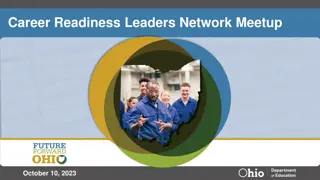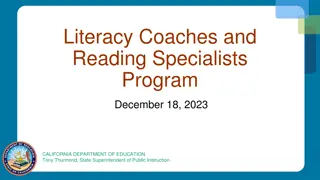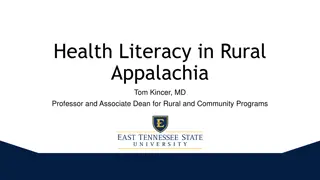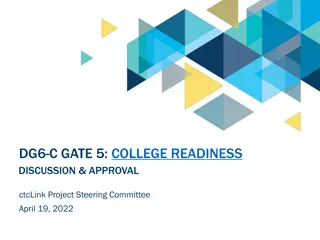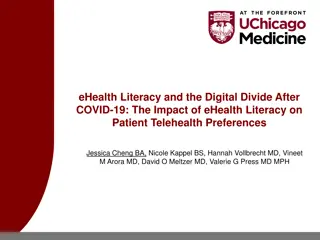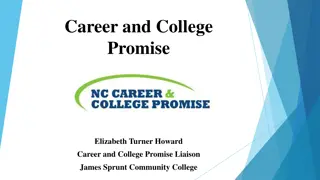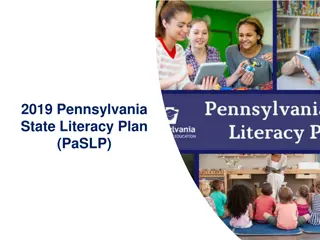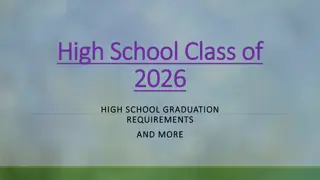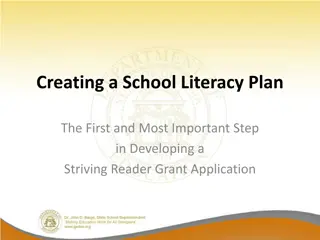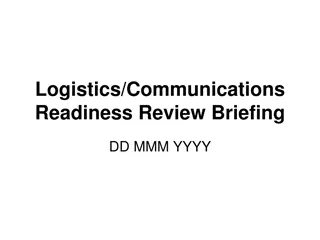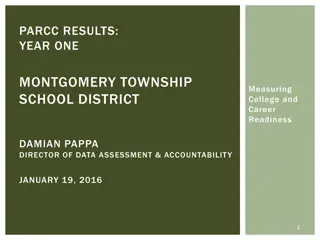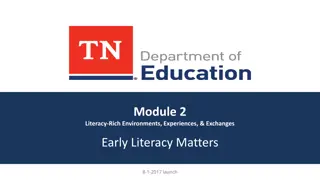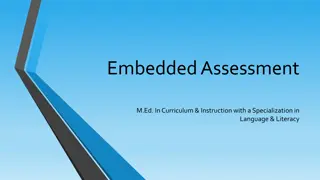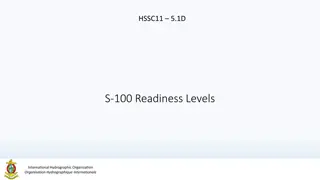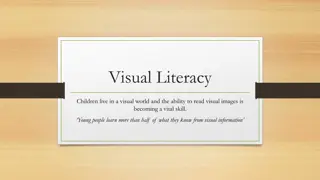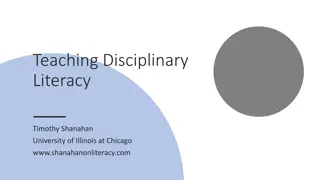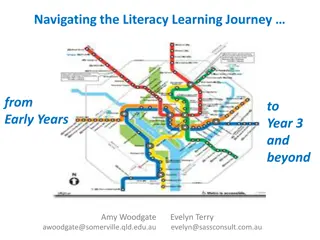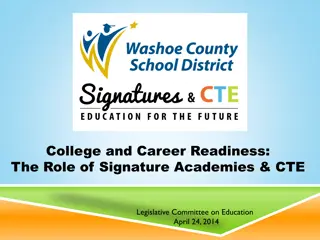College and Career Readiness in Literacy Goals
This content focuses on the goals outlined by the Council of Chief State School Officers and National Governors Association to ensure all students are college and career ready in literacy by the end of high school. It discusses the importance of independence, strong content knowledge, response to audience demands, critical thinking, technology use, understanding of diverse perspectives, and key features of standards in reading, writing, speaking, listening, and language use.
Download Presentation

Please find below an Image/Link to download the presentation.
The content on the website is provided AS IS for your information and personal use only. It may not be sold, licensed, or shared on other websites without obtaining consent from the author.If you encounter any issues during the download, it is possible that the publisher has removed the file from their server.
You are allowed to download the files provided on this website for personal or commercial use, subject to the condition that they are used lawfully. All files are the property of their respective owners.
The content on the website is provided AS IS for your information and personal use only. It may not be sold, licensed, or shared on other websites without obtaining consent from the author.
E N D
Presentation Transcript
BACKGROUND INFORMATION 1. 1. Goal: help ensure that all students are college and career ready in literacy by the Goal: help ensure that all students are college and career ready in literacy by the end of high school end of high school Council of Chief State School Officers & National Governor s Association Council of Chief State School Officers & National Governor s Association Based on feed Based on feed- -back from a wide group of interested parties. back from a wide group of interested parties. AZCCR ELA standards in history/social studies, science and technical subjects do NOT AZCCR ELA standards in history/social studies, science and technical subjects do NOT replace content standards. replace content standards. 5. In 5. In an executive order, the governor said she was reaffirming Arizona s right to set an executive order, the governor said she was reaffirming Arizona s right to set education policy. Her order spells out no standards or curriculum shall be imposed education policy. Her order spells out no standards or curriculum shall be imposed on Arizona by the federal government. on Arizona by the federal government. Sept 23, 2013 Sept 23, 2013 6. 6. Define what ALL students are expected to know and be able to do, NOT on how Define what ALL students are expected to know and be able to do, NOT on how teachers should teach p.7 ACCR guide lines teachers should teach p.7 ACCR guide lines 2. 2. 3. 3. 4. 4.
NOT STANDARDS, BUT GOALS 1. Demonstrate independence: w/o scaffolding, comprehend and evaluate complex texts across all content areas. ..become self-directed learners, be resourceful. 2. Build Strong Content knowledge: wide range of content knowledge; share their knowledge through writing and speaking 3. Respond to varying demands of audience, task, purpose and discipline: recognize characteristics of audience. 4. Comprehend as well as Critique: open-minded, discerning, listening; use evidence to support ideas 5. Use technology and digital media: enhance their reading, writing, speaking, listening, and language use. Be able to be efficient with online research 6. Understand other perspectives and cultures
KEY FEATURES OF STANDARDS Reading: Text complexity Reading: Text complexity Writing: Text types, responding to reading and research (evidence) Writing: Text types, responding to reading and research (evidence) Speaking and Listening: formal presentations, intrapersonal skills, work together, Speaking and Listening: formal presentations, intrapersonal skills, work together, listen to ideas listen to ideas Language: Conventions, effective use and vocabulary. Language: Conventions, effective use and vocabulary.
ACCR SHIFTS AND ANCHOR STANDARDS Shift Shift 1 1 Balancing Balancing Informational Students read a true balance of informational and literary texts. Students read a true balance of informational and literary texts. Shift Shift 2 2 Knowledge Knowledge in the Disciplines in the Disciplines Students build knowledge about the world (domains/ content areas) through TEXT rather than the teacher or Students build knowledge about the world (domains/ content areas) through TEXT rather than the teacher or activities activities Shift Shift 3 3 Staircase Staircase of Complexity of Complexity Students read the central, grade appropriate text around which instruction is centered. Teachers are patient, Students read the central, grade appropriate text around which instruction is centered. Teachers are patient, create more time and space and support in the curriculum for close reading. create more time and space and support in the curriculum for close reading. Shift Shift 4 4 Text Text- -based Answers based Answers Students engage in rich and rigorous evidence based conversations about text. Students engage in rich and rigorous evidence based conversations about text. Shift 5 Shift 5 Writing Writing from Sources from Sources Writing emphasizes use of evidence from sources to inform or make an argument. Writing emphasizes use of evidence from sources to inform or make an argument. Shift Shift 6 6 Academic Academic Vocabulary Vocabulary Students constantly build the transferable vocabulary they need to access grade level complex texts. This can be Students constantly build the transferable vocabulary they need to access grade level complex texts. This can be done effectively by spiraling like content in increasingly complex texts. done effectively by spiraling like content in increasingly complex texts. Informational & & Literary Text Literary Text
ENGLISH LANGUAGE STANDARDS READING STANDARDS READING STANDARDS Literature and Informational Text Literature and Informational Text Key ideas, Details Key ideas, Details Craft and Structure Craft and Structure interpret words, phrases, POV interpret words, phrases, POV Integration of Knowledge and Ideas Integration of Knowledge and Ideas integration/evaluation, arguments, compare & contrast compare & contrast integration/evaluation, arguments, Range of Reading and Level of Text Complexity Range of Reading and Level of Text Complexity independence and proficiently independence and proficiently
WRITING STANDARDS 1. 1. Text Types and Purposes Text Types and Purposes argumentative, informational, argumentative, informational, etc etc 2. 2. Production and Distribution of Writing Production and Distribution of Writing development, organization and style appropriate for task/audience style appropriate for task/audience development, organization and 3. 3. Research to Build and Present knowledge Research to Build and Present knowledge investigation, use multiple sources, evidence evidence- -based. based. investigation, use multiple sources, 4. 4. Range of Writing Range of Writing Write all the time!!! Long Write all the time!!! Long- -term and short term and short- -term assignments term assignments
SPEAKING AND LISTENING STANDARDS 1. 1. Comprehension and Collaboration Comprehension and Collaboration Participate effectively w/wide group of diverse partners, build on other s ideas Participate effectively w/wide group of diverse partners, build on other s ideas Integration of ideas from presentations and other media sources Integration of ideas from presentations and other media sources Evaluation of speaker s POV, evidence, Evaluation of speaker s POV, evidence, etc etc 2. 2. Presentation of Knowledge and Ideas Organization of research/evidence in logical structure. Organization of research/evidence in logical structure. Strategic use and integration of digital media. Data, graphs, imbedded media Strategic use and integration of digital media. Data, graphs, imbedded media Use of academic, formal English language. Use of academic, formal English language.
DEFENDING THE MISSION But the Common Core (or whatever your state decides to call it) is all about analysis; But the Common Core (or whatever your state decides to call it) is all about analysis; the idea is that the Dear Jack student , within the new guidelines, should not only the idea is that the Dear Jack student , within the new guidelines, should not only be able to solve the problem, but to articulate why another student got it wrong. be able to solve the problem, but to articulate why another student got it wrong. This is an effort to combine simple math with analysis and literacy, and what the This is an effort to combine simple math with analysis and literacy, and what the common core is trying to accomplish; it is not a curriculum, but common core is trying to accomplish; it is not a curriculum, but a a clear shared goals and expectations shared goals and expectations for for what knowledge and skills will help our what knowledge and skills will help our students succeed students succeed. (Common Core Mission Statement) . (Common Core Mission Statement) clear set of set of
READING: TEXT DEPENDENT QUESTIONS 1. 1. The new standards reflect an effort to require students to be able to reference The new standards reflect an effort to require students to be able to reference the text directly to answer questions, rather than simply generalizing . (aka B.S. the text directly to answer questions, rather than simply generalizing . (aka B.S. ing ing) ) 2. 2. The idea is that students should be able to provide The idea is that students should be able to provide evidence and articulate that evidence. This is what has students and parents frustrated, and articulate that evidence. This is what has students and parents frustrated, and has caused some of the backlash as seen on the Glenn Beck show: and has caused some of the backlash as seen on the Glenn Beck show: evidence for their thinking, for their thinking,
PQ4R Preview Preview Preview Preview text what s emphasized, organization what s emphasized, organization text- - title, visuals, headings, sub headings, title, visuals, headings, sub headings, Question Form questions Read Formulate answers to questions; annotate Reflect Connections to prior knowledge; big ideas, so what? Recite State main points out loud. Generate questions (levels of complexity) Review Summarize, abstracts, One-Pagers, assessments



